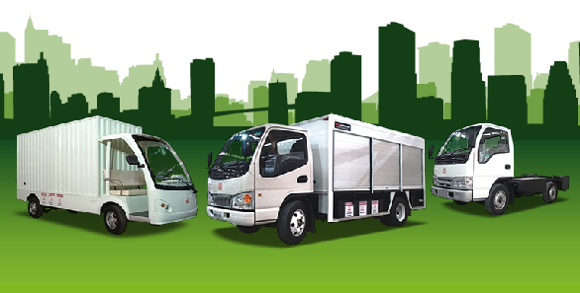 This is the second in a continuing series on electric vehicle transportation. Our first look at EV’s can be found here.
This is the second in a continuing series on electric vehicle transportation. Our first look at EV’s can be found here.
CalStart President & CEO John Boesel recently spoke with Clean Air Roadmap about the state of electric trucks and what he sees as a promising future for a rapidly advancing technology that can clean our air while reducing pollution and operating costs. CalStart is an internationally known catalyst for the advanced transportation industry. CalStart works with manufacturers, suppliers, fleets, public agencies, and policy makers to bring clean, efficient technologies to market. John and CalStart are celebrating their 20th Anniversary this year.
Electric, hybrid and plug-in hybrid cars have received a lot of attention in the news over the past couple of years, however, their counterparts in the trucking sector have largely gone unnoticed. The MSRC, along with other agencies, has begun providing incentive funding for electric trucks and charging infrastructure including a grant to Frito-Lay to support aggressive adoption of electric trucks for its California fleet.
Deployment of trucks powered in-part or wholly by batteries is just beginning to take place in commercial fleets in California and nationally. In addition to Frito-Lay, UPS and Federal Express have been adding electric vehicles to their fleets and carefully monitoring their performance in the field.
While electric trucks can save upwards of $50,000 per year on fuel and maintenance costs and reduce 100 tons of CO2 each a year, according to a recent LA Times story, the technology is still at an early, though very promising stage of development.
But is electric truck technology ready for prime time?
“Yes, it’s more than adequate. The trucks are being manufactured now. The real issue is creating the business case for the appropriate type of truck to be deployed to provide the appropriate business need. We are already seeing that with the proper levels of incentives, there’s a great case for hybrids as well as plug-in electric trucks.” John explained, adding that “like with most new technologies, the initial cost for electric trucks is still significantly higher than conventional trucks. Reducing the cost will require getting the technology to scale. If California, and Southern California leaders want to increase the chances that we’ll have healthy air by 2030, then we should plan on seeing incentives in place to reduce the initial purchase price through at least 2020.”
Types of Alternative Trucks
Just like with electric drive passenger cars, there are conventional hybrid trucks (analogous to the Prius), plug-in hybrid trucks (analogous to the Chevy Volt and plug-in Prius) and pure electric trucks (analogous to the Nissan Leaf). There’s also a hydraulic hybrid truck that doesn’t use a chemical battery but stores braking energy in a hydraulic cylinder. John told us there’s a growing interest in all truck sectors, but the zero–emission, solely electric trucks are gaining more traction where they can replace conventional light duty diesel trucks (class 3-5) for dense urban routes. One of the barriers for businesses is that while there is a significant expansion in the choices of new vehicles for different segments, many companies don’t have enough information on their trucks and routes to determine the best option for their needs. For example, CNG trucks are more appropriate for reduced emissions for longer hauls and EVs are more appropriate for deliveries of products over shorter distances. John really commends companies such as PepsiCo/Frito-Lay, Fed Ex and UPS who are collecting data on all their trucks. They have a better understanding of how each truck is used in each setting. Armed with that knowledge they’re deploying EV trucks on routes where they can be most effective
Why Businesses are Switching
John says that more and more he sees companies truly interested and motivated in doing the right thing – especially when they can make a compelling business argument for doing so. With incentives, companies already are seeing a positive return on investment in electric trucks. He added that companies “also really have a growing sense of distrust of the oil market and the risk associated with wild price fluctuations. If companies can reduce their exposure to the global oil commodity, that is a good business decision.”
Batteries
Currently, batteries are still quite expensive and the lifespan for electric trucks is 8-10 years. However, John explains that we’ll soon have an answer on the feasibility of secondary battery life when a battery that may be at 70% capacity is no longer optimal for powering a truck, it will have great capacity for storing grid power as a back-up power source.
Infrastructure
John explained that, while the charging equipment for trucks is the same 240 volt charger that is used by electric passenger cars, depending on the location and number of chargers that a company requires, the cost for installation can range from virtually zero to quite significant and even cost-prohibitive. Additionally, while electricity is significantly cheaper than gas prices, the large number of utilities in California have significant pricing variation. Some leading utilities like Southern California Edison are offering attractive off-peak rates when the majority of trucks are charged overnight or in the morning when demand is low. Determining infrastructure cost for a fleet is an important element of the decision-making process.
How Many Trucks are on the Road
Today there are more than 1,000 hybrid and electric trucks on California’s roads (20% of the nation’s total such deployed trucks). That compares with close to 1 million conventional trucks on our roads, so there’s obviously a ways to go in making a significant dent in reducing truck pollution.
What are Growth Expectations Over the Next 5-10 years
If we just take a business as usual approach, John says we’ll see a 10-20% annual growth in electric trucks. But if there are incentives from revenues of cap and trade programs to provide additional incentives for these types of vehicles or if there’s a meaningful price on carbon, we could see a much faster adoption of the technology. Since there are no zero emission targets for trucks as there are for passenger cars, incentives are even more important. Additionally, John noted that last year, we had the first-ever national fuel economy and greenhouse gas standards for the trucking sector through 2018 – (equivalent to CAFÉ standards for passenger cars). We’ll likely see a second round of regulations for post -2018.
John concluded our interview by saying that CalStart is celebrating its 20th Anniversary year and the most exciting development over those two decades is that “we’ve gone from prototype to production and the next 20 years is about mainstreaming and making technologies affordable.”
E-Truck Task Force Overview & Recommendations
CalStart recently formed an E-Truck Task Force to target specific issues in the emerging electric truck market. In total, the Task Force consists of 102 members representing OEMs, supplier companies, government agencies, academic organizations, and 37 public and private fleets.
As a result of this multi-month research and industry engagement process, CalStart has published a white paper, entitled "Best Fleet Uses, Key Challenges and the Early Business Case for E-Trucks: Findings and Recommendations of the E-Truck Task Force," which highlights the key findings and recommendations of the Task Force. These recommendations represent important actions needed to support and expand the production and use of electric and plug-in trucks. The white paper concludes that E-trucks can achieve payback and satisfy fleet user needs even in the early market if the trucks are placed in applications that provide high daily petroleum offset (either in mileage or energy use) and can maintain high utilization rates. Special additions to this white paper include an E-truck Business Case Calculator that can aid fleets in their business case calculations. The white paper also includes an Infrastructure Planning Guide for E-Truck Fleets, which is designed to help fleets avoid unexpectedly high initial infrastructure costs and electricity demand charges.
The top-level recommendations from the E-Truck Task Force are briefly outlined below and detailed further in the report.
Minimize costs:
• Call on the vehicle and battery industry to institute a battery leasing model for E-trucks and/or a greatly extended battery warranty
• Maintain or increase R&D and demonstration of hybrid and electric technology for trucks with a focus on reduced system design and manufacturing costs
• Seek support incentives – ideally purchase vouchers – for roughly half of E-truck incremental costs
Improve vehicle quality / support:
• Call on vehicle and battery industry to directly link sales expansion to establishment of a satisfactory support and parts network
• Call on vehicle manufacturers to increase quality control checks before delivery
• Encourage fleets to require service turn-around minimums before agreeing to purchase
Provide better performance validation data and business case information:
• Create and circulate a general business case calculator/guide to help fleets assess best applications for vehicle use
Action taken: Calculator created and included with report
• Create a clearinghouse for fleet in-use data sharing on E-trucks
• Create joint info/data documents and tools highlighting best use profiles, agree to common use profiles to aid business case planning and agree to their use across the E-truck industry
Provide information on charging infrastructure requirements and costs:
• Create and circulate a general infrastructure installation and planning guide
Action taken: Guide created and included with report
• Work to create a commercial EV charging rate
• Eliminate or reduce demand charge for commercial EV charging (if timed to protect the grid)
• Create incentives to offset infrastructure costs that are provided together with vehicle incentives (ideally provided via voucher or similar structure)
